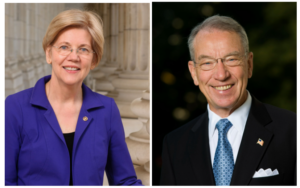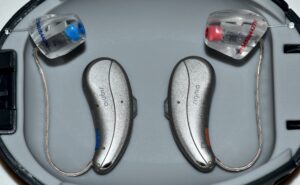By David Wilkening
Contributing Writer

REGION – More than a half million people in the state of Massachusetts have some sort of hearing problem. Often it’s age-related and neglected as well. One survey found surprisingly low numbers of individuals aged 29 to 69 with hearing loss, only 14 percent, use some sort of hearing aids. Blame that mainly on high prices.
But that’s all about to change.
It’s due to long-sought new rules from the federal government’s U.S. Food and Drug Administration (FDA). Because of that change―in large part due to the work of a senator from Massachusetts―hearing aid users will be able to buy normally expensive devises at a lower cost. And the performance of the devices may also be improved.
That’s the generally accepted positive side of the change.
Potential drawback
But on the other side―consumers will have to make their own medical decisions without the requirement of professionals, and that could be a potential drawback.
Sen. Elizabeth Warren (D-Mass.) and Sen. Chuck Grassley (R-Iowa) issued the following joint statement after the Food and Drug Administration (FDA) finalized a key rule allowing hearing aids to be sold over-the-counter, an effort they have worked on since 2017:
“Five years after our bipartisan Over-the-Counter Hearing Aid Act became law, consumers with mild to moderate hearing loss will finally have access to affordable over-the-counter hearing aids,” said Warren and Grassley. “We’ve pressed the FDA to take action every step of the way―holding both Republican and Democratic administrations accountable―and fought back against entrenched special interests. We are thrilled that the FDA has finalized these guidelines and that safe, effective, accessible and affordable hearing aids will now be available over-the-counter for millions of Americans.”
On the other hand, “The recent U.S. Food and Drug Administration rule allowing consumers to buy hearing aids over-the-counter could prompt patients to become their own doctors and not receive the professional care they need,” warned one expert.
Dr. Nicole Laffan, assistant clinical professor at Bouvé College of Health Sciences and the Audiology Clinic director at the Northeastern’s Speech-Language and Hearing Center, believes that the best practice is to receive professional care for hearing loss and get a prescribed hearing device. She is concerned that the new FDA rule encourages patients to become their own doctors and to determine the level of their hearing loss based on perception.
Laffan feels strongly that those who treat hearing loss need to educate the public on what it means to get a hearing aid.
Cost savings
Both sides generally agree that costs will be reduced mainly because users with low or moderate hearing losses will now be able to buy hearing aids directly from a store or online. They will no longer be required to have a custom fitting from a professional. They can shop at Wal-Mart or Best Buy.
It’s a major change since hearing loss affects many Americans with a myriad of physical and psychological problems that are not always at a high volume of awareness. About one in eight people in the U.S. ages 12 and older has hearing loss in both ears, however, and the rate increases significantly with age. About a quarter of people 65 to 74 have hearing loss, and that goes up to 50 percent around age 75, according to recent figures from the federal government.
It’s somewhat of a quiet issue. If hearing loss were officially considered a disability by the government, for example, it would be the largest disability class in the country.
People with hearing loss who did not have hearing aids are more likely to report poor health overall, and they are less likely to leave home or exercise, studies have found.
U.S. officials estimate as many as 80 percent of the roughly 30 million Americans with mild to moderate hearing loss go untreated even though they could benefit from the most common type of hearing aids, known as air-conduction devices.
How did this new rule happen? But more importantly: what does it mean for you?
The rule’s long journey
The changed law acquired some strange fellow travelers: One is the unlikely alliance of former President Trump and liberal Massachusetts Senator Elizabeth Warren (“It’s the one issue we can agree on,” she said).
Congress passed legislation to create a category of OTC (over-the-counter) hearing aids with wide bipartisan support, and President Trump signed it into law in 2017.
But no action was taken, and Sen. Warren, a sponsor of the bill, gave the FDA a deadline to issue the regulations. She and co-sponsor Sen. Chuck Grassley sent several letters urging the FDA to take action.
In July 2021, President Biden signed an executive order created in part to speed things along.
The FDA was in no hurry to comply.
The FDA initially said the pandemic delayed the implementation of the October-issued rule. The agency also blamed delays on required public comments.
The Food and Drug Administration responded with a press release that the long-awaited change would make the devices much more widely available and would lower prices. At the same time, those hearing-impaired will be far more likely to afford them.
“Today’s action will not only help adults who have perceived mild to moderate hearing loss gain access to more affordable and innovative production options, but we expect that it will unleash the power of American industry to improve the technology in a way that it will impact the enormous burden of disability from hearing loss affecting the world,” FDA Commissioner Dr. Robert Califf said.
The rule doesn’t change how hearing aids are covered. While private insurers pay for treatment after the loss of a limb and even cover the cost of Viagra, most do not cover hearing aids. Basic Medicare doesn’t pay for them either.
Hearing aids are expensive. And five large companies have had control over 90 percent of the global market. That kind of consolidation meant there was little price competition, and high prices may be a big reason why most people who need hearing aids don’t have them.
On average, people spend at least $4,000 out of pocket for devices for both ears, according to a 2020 study published in the Journal of the American Medical Association. Prices vary widely, often between $1,400 to $6,000 for one ear device, according to estimates.
The FDA estimates that the new rule could mean savings of about $2,800 a pair.
With the change, many more companies are expected to enter the market.
Experts believe that existing manufacturers will also develop lower-cost over-the-counter devices in addition to their current offerings.
How the new rule works

People in the past could get hearing aids only with an expensive medical exam or prescription from a professional who will fit the device for the individual. Audiologists can also adjust it over its lifetime if someone’s hearing gets worse.
With an over-the-counter device, buyers may be able to adjust them on their own.
The new rule applies only to certain kinds of hearing aids, the FDA said. People with severe hearing loss and those under the age of 18 will still need a prescription.
To be allowed on the market, the new rule says, over-the-counter hearing aids will need to meet the FDA’s high standards for safety, labeling and manufacturing protection like all other medical devices.
Health care professionals also anticipate that many with mild or moderate hearing loss may initially buy hearing aids over-the-counter but eventually consult audiologists for hearing evaluations.
The Boston-based Northeastern Speech-Language and Hearing Center, and the Hearing Loss Association of America are among credible sites offering guidance on what to know when shopping for hearing aids.
A very first suggestion is to get a test to gauge the degree of hearing loss, which varies widely.
They also urge that since hearing aids are a major investment, buyers make sure a purchase comes with a guarantee, and that there are some provisions for altering a device if hearing changes.
RELATED CONTENT:
Noise pollution is more than an inconvenience (fiftyplusadvocate.com)
Hearing loss intervention can be life changing for older adults (fiftyplusadvocate.com)












